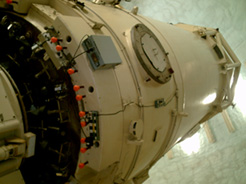
The 2dcoudéSpectrograph
McDonald Observatory and Department of Astronomy
The University of Texas at Austin
2511 Speedway, RLM Hall 15.308
1 University Station, C1400
Austin, TX 78712 USA
|
| Grating tables prepared by Bob Tull |
| Th-Ar Atlas at F3 |
| 2dcoudé atlas of Procyon |
| Tom Barnes' manual |
| 2.7m TCS Manual |
![]()
The 2dcoudéspectrograph provides cross-dispersed high dispersion spectroscopy at the 2.7m Harlan J. Smith telescope. Dr. Robert G. Tull is the magician responsible for this instrument. Here is the basic information on the spectrograph.
 |
The 2.7m telescope on top Mount Locke was finished in 1968, and is still working at its best, especially after the new telescope control system was installed in 1999. The telescope collects the light from stars and other astronomical objects. The light hits the (2.72 m = 107 inches) primary mirror, then the secondary, and then it is diverted, with the help of two flat mirrors, down the axis to the coudé room. There, the focal length is 88.43 meters, and the size of the field is 3 arcmin. Here is more information about the telescope. |
 |
At the end of the tube, you'll find the slit room, where the light hits a third flat mirror and ends up focused on the slit . The light that doesn't make it into the spectrograph is detected by a TV camera, for guiding. The light that enters into the spectrograph has still a long way ahead. The spectrograph occupies a large room, where the light is passed through various mirrors, lenses (as the one on the right side of the picture), a pair of prisms attached to each other (on the left), and a diffraction grating (right behind the prisms), before landing on the detector, which goes by the name of TK3. |
 |
TK3 is a 2048x2048 (24 µm) pixels Tektronix CCD with a very low read-out noise: just a few electrons. Cooled to a very low temperature with N2 , the dark current is just negligible. Dr. Phillip J. MacQueen is responsible for this jewel. With this detector, the resolving power can be as high as ~ 60,000 at focus F3, or up to 220,000 at F1. The prisms we talked about, shown on the previous picture, provide the cross-dispersion, so it is possible to observe 10-62 spectral orders simultaneously. The main purpose of this page is to provide 2dcoudé observers with some tools to help planning their observations, a place to post any relevant information on this instrument. First of all, here is a link to the paper that describes the spectrograph: Tull, MacQueen, Sneden & Lambert (1995). |